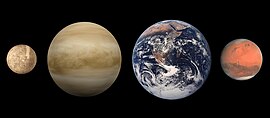Our website is made possible by displaying online advertisements to our visitors.
Please consider supporting us by disabling your ad blocker.
Planet
A planet is a large object such as Venus or Earth that orbits a star. Planets do not make light but can reflect light.
Jupiter is the biggest planet in the Solar System, while the smallest planet in the Solar System is Mercury.
Planets are shaped like a slightly squashed ball (called a spheroid). Objects that orbit planets are called satellites. A star and everything which orbits it are called a star system.
There are eight planets in the Solar System. Pluto used to be called a planet, but in August 2006, the International Astronomical Union decided it was a dwarf planet instead. There are eight more known dwarf planets in the Solar System, Ceres, Eris, Makemake, Haumea, Quaoar, Orcus, Gonggong, and Sedna.
The name "planet" is from the Greek word πλανήτης (planetes), meaning "wanderers", or "things that move".
Until the 1990s, people only knew the planets in the Solar System. Since then 4,905 extrasolar planets (exoplanets) have been discovered in 3,629 planetary systems (January 2022 data). The count includes 808 multi-planetary systems. Known exoplanets range in size from gas giants about twice as large as Jupiter down to just over the size of the Moon. About 100 of these planets are roughly the size as Earth. Nine of these orbit in the habitable zone of their star.[1][2]
- ↑ "NASA discovery doubles the number of known planets". USA TODAY. 10 May 2016. Retrieved 10 May 2016.
- ↑ Schneider, Jean (16 January 2013). "Interactive Extra-solar Planets Catalog". The Extrasolar Planets Encyclopaedia. Retrieved 2013-01-15.
Previous Page Next Page




